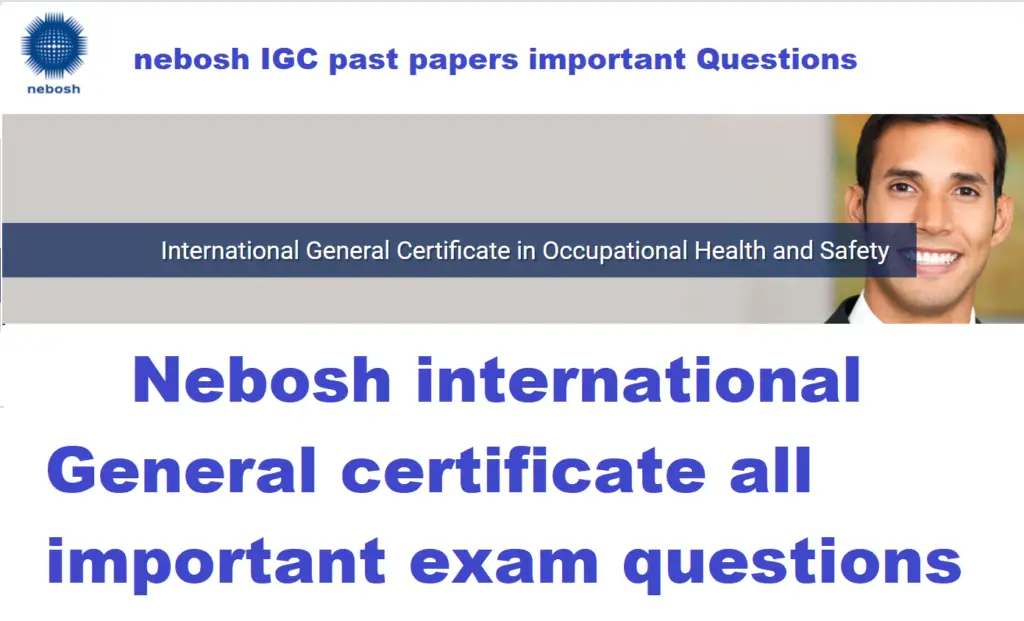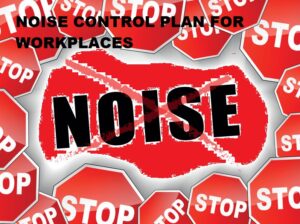nebosh IGC past exam papers important questions

nebosh IGC safety course past exam papers important questions UNIT: GC 2
El. 1. Workplace Hazards
1. Periodic maintenance on a large item of machinery will require workers to work at height.
- Identify factors that should be considered in order to assess working at height risks. (4)
- Outline safety measures that could be used in order to help reduce the working at height risks. (8)
- Outline control measures that may be required for the safe maintenance of the machinery. (8)
2. The influence of drugs on workers in a workplace can have a significant effect on health and safety.
(a) Identify possible reasons why a worker may be in possession of drugs in the workplace. (2)
(b) Outline control measures that an employer could take in order to help reduce the
misuse of drugs in the workplace. (6)
3. (a) Give reasons why accidents may occur on stairs. (4)
(b) Identify ways in which accidents on stairs may be prevented. (4)
4. Excavation work is going on in a workplace.
(a) Outline precautions for persons working at ground level near deep excavations. (4)
(b) Outline precautions required to avoid the risk from contact with existing underground services. (4)
nebosh IGC past exam papers important questions
El. 2: Safe movement of Vehicles.
1. Outline control measures that could be implemented in order to help reduce risks to pedestrians in a warehouse
where separate traffic routes cannot be provided. (8)
2. Drivers in a warehouse distribution centre are to have driver training.
Identify factors that should be included in a training programme for drivers in order to help reduce the risk of accidents to themselves and other workers. (8)
3. Outline control measures that could be used to reduce the risk to pedestrians in vehicle manoeuvring
areas. (8)
El. 3: Musculoskeletal hazards
1. A computer user has complained of neck and back pain.
Outline features associated with the workstation that might have contributed towards this
condition. (8)
2. (a) Give the meaning of the term ‘work related upper limb disorder’ (WRULD) (2)
(b) Give examples of occupations that could cause ‘WRULDs’. (2)
(c) Outline possible causes of WRULDs. (4)
3. Explain why a supermarket checkout operator may be at risk of developing a WRULD. (8)
4. Identify ill-health effects that can be associated with WRULDs. (5)
5. Outline appropriate control measures that could help reduce the risk of WRULDs among
check-out operators. (5)
6. Outline ways to improve the task of a manual handling activity that will reduce the risk of injury. (8)
El. 4. Work-equipment hazards
1. (a) Outline reasons why an item of machinery should be maintained. (4)
(b) Outline ways to reduce the risk of injury from the moving parts during the maintenance activities
on the machinery. (4)
2. (a) Describe when a fixed guard would be an appropriate means of providing protection against mechanical hazards. (2)
(b) Outline features of fixed guards design to minimise the risk of injury and ill – health from the mechanical and non – mechanical hazards of machinery. (6)
3. Portable electrical equipment should have sufficient strength and capability to be suitable for use.
(a) Identify factors that should be considered when assessing the strength and capability of portable electrical equipment. (4)
(b) Outline a strategy for maintenance and inspection of portable electrical equipment so that the equipment remains suitable for use and in a safe condition. (4)
4. Describe the principles of operation of:
(a) sensitive protective equipment (trip devise) (2)
(b) a two-handed control (2)
(c) an interlocked guard (2)
(d) a protective appliance (2)
El. 5: Electrical safety
1. Outline examples of faults and bad practices that could contribute to electrical accidents when using portable
electrical equipment in the workplace. (8)
2. Outline how the following two protective measures reduce the risk of electric shock AND, in EACH case, give an example of its application:
(a) reduced low voltage; (4)
(b) double insulation. (4)
El. 6: Fire Safety
1. (a) Describe the consequences of fire in a work place. (4)
(b) Outline how ignition sources can be controlled in a workplace. (4)
2. Substantial changes are to be made to the internal layout of a workplace.
Outline factors that should be considered when reviewing the fire risk assessment. (8)
3. An extension providing additional rooms for accommodation has been added to the existing building of a nursing home.
4. Outline factors that should be considered when reviewing the fire risk assessment for the nursing home. (8)
5. Give reasons that may delay the safe evacuation of workers from a workplace during a fire. (8)
El. 7 Chemical and biological health hazards
1. (a) Identifypossible routs of entry of biological agents in to the body. (4)
(b) Outline control measures that could be used to help reduce the risk of exposure to biological
agents. (4)
2. Absorbent mats and granules have been used to soak up a chemical spillage.
Outline issues that will need to be considered when handling and storing the waste material prior to
its collection. (8)
3. (a) Identify health risks associated with exposure to silica dust. (1)
(b) Identify workplace circumstances where silica dust may be present. (2)
(c) Outline precautions that will help reduce the risks from exposure to silica dust. (5)
4. A small quantity of paint is applied by brush to components in a workshop. Safety data sheet supplied with the paint indicates that this paint is both an irritant and carcinogenic. Workers have been observed regularly licking the tip of the paint brush during use and wiping excess paint from the components with their finders.
(a) Give the meaning of the following terms:
(i) Irritant (2)
(ii) Carcinogens (2)
(b) Explain why the observed method of working may increase the risk of ill-health. (2)
(c) Identify ways in which the health of the workers can be monitored. (2)
5. Outline factors to consider when carrying out an assessment of the risks to health from the hazardous substances. (8)
6. Outline control measures required to reduce the risk of exposure to hazardous substances to library workers and members of the public. (8)
7. (a) Identify a health risk associated with exposure to the Leptospira bacteria. (1)
(b) Identify workplace circumstances where Leptospira bacteria may be present. (2)
(c) Outline precautions that will reduce the risks from exposure to Leptospira bacteria. (5)
8. Outline cleaning and housekeeping requirements in a workplace. (8)
9. An electricity-powered chemical pump, operating at 90 degree C has developed a leak.
Outline control measures that should be taken during the repair of the item of machinery. (8)
El. 8. Physical and Psychological hazards
1. Drivers of vehicles can be exposed to whole – body vibration (WBV).
(a) Give the meaning of term ‘whole – body vibration ‘. (2)
(b) Outline control measures that can be taken to help reduce the risks
from whole – body vibration. (6)
3. An organisation has identified that noise measurements in the workplace are required.
(a) Give the meaning of the following terms:
(i) Frequency (2)
(ii) Decibel (dB) (2)
(iii) A-weighting (2)
(b) Identify types of noise measurement techniques. (2)
4. (a) Identify TWO types of non-ionising radiation AND give an occupational source for EACH. (4)
(b) Outline health effects associated with exposure to non-ionizing radiation. (4)







